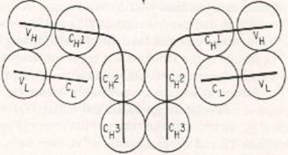So now that we've introduced tertiary structure, we can talk about protein motifs and domains. It turns out that tertiary protein structure actually includes the distribution of secondary structures such as alpha helices, beta strands, beta turns, and loops to make protein motifs and protein domains. Just to get you guys oriented on the hierarchy of all of these terms and structures, we've got this image below. Of course, at the lowest level of the hierarchy, composition, as well as amino acid sequence, and the sequence is the particular order of amino acids from the N-terminal to the C-terminal of a polypeptide chain.
Then, what we have is our secondary structures, and we talked about multiple types of secondary structures including alpha helices, beta sheets, and, loops and beta turns. Then what we did was we jumped straight from secondary structure to tertiary structure. Now that we've got tertiary structure introduced, we can better understand this organization. It turns out that secondary structures actually come together to form super secondary structures, which are also known as domains, which are just independent folding units.
Together, the motifs and the domains, as you can see by this bracket here, they come together to form the tertiary structure which we know as the overall three-dimensional shape of the protein. So, what we're going to do first is talk about the super secondary structures or the motifs, and then, once we're done talking about the motifs, we'll go and we'll talk about the protein domains. So, I'll see you guys in our next video where we'll talk about protein motifs.








